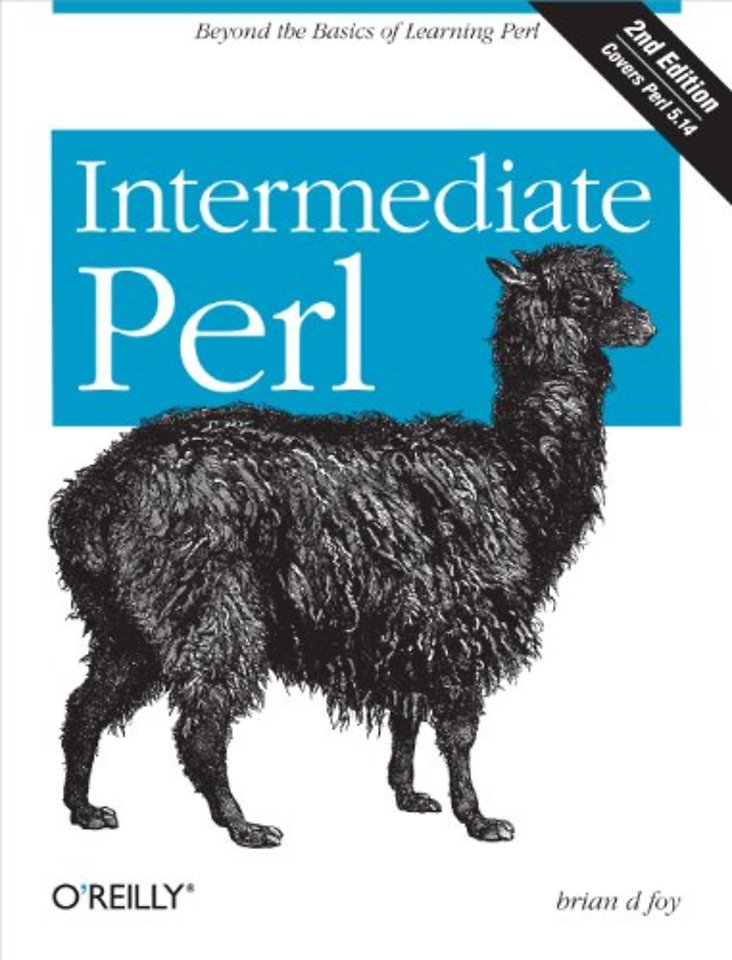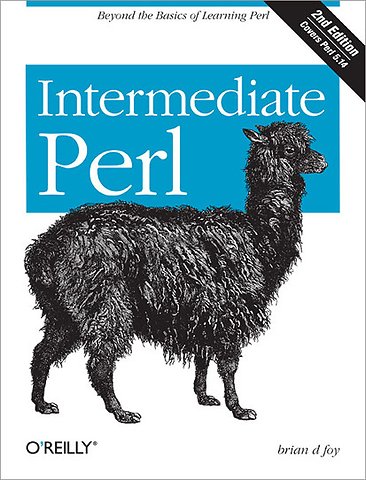


Randal L. Schwartz is a two-decade veteran of the software industry. He is skilled in software design, system administration, security, technical writing, and training.
Meer over de auteursIntermediate Perl (Covers Perl 5.14)
Beyond the Basics of Learning Perl
Samenvatting
This book picks up right where 'Learning Perl' leaves off. With 'Intermediate Perl', you'll graduate from short scripts to much larger programs, using features that make Perl a general-purpose language. This gentle but thorough guide introduces you to modules, complex data structures, and object-oriented programming.
Each chapter is small enough to be read in just an hour or two, ending with exercises to help you practice what you've learned. If you're familiar with the material in 'Learning Perl' and have the ambition to go further, Intermediate Perl will teach you most of the core Perl language concepts you need for writing robust programs on any platform.
Topics include:
- Packages and namespaces
- References and scoping, including regular expression references
- Manipulating complex data structures
- Object-oriented programming
- Writing and using modules
- Testing Perl code
- Contributing to CPAN
Just like 'Learning Perl', material in this book closely follows the popular introductory Perl course the authors have taught since 1991. This second edition covers recent changes to the language up to version 5.14.
Specificaties
Inhoudsopgave
Preface
1. Introduction
-What Should You Know Already?
-strict and warnings
-Perl v5.14
-What About All Those Footnotes?
-What's With the Exercises?
-How to Get Help
-What If I'm a Perl Course Instructor?
-Exercises
2. Using Modules
-The Standard Distribution
-Exploring CPAN
-Using Modules
-Functional Interfaces
-Object-Oriented Interfaces
-What's in Core?
-The Comprehensive Perl Archive Network
-Installing Modules from CPAN
-Setting the Path at the Right Time
-Setting the Path Outside the Program
-local::lib
-Exercises
3. Intermediate Foundations
-List Operators
-Trapping Errors with eval
-Dynamic Code with eval
-The do Block
-Exercises
4. Introduction to References
-Doing the Same Task on Many Arrays
-PeGS: Perl Graphical Structures
-Taking a Reference to an Array
-Dereferencing the Array Reference
-Getting Our Braces Off
-Modifying the Array
-Nested Data Structures
-Simplifying Nested Element References with Arrows
-References to Hashes
-Checking Reference Types
-Exercises
5. References and Scoping
-More than One Reference to Data
-What If That Was the Name?
-Reference Counting and Nested Data Structures
-When Reference Counting Goes Bad
-Creating an Anonymous Array Directly
-Creating an Anonymous Hash
-Autovivification
-Autovivification and Hashes
-Exercises
6. Manipulating Complex Data Structures
-Using the Debugger to View Complex Data
-Viewing Complex Data with Data::Dumper
-Marshalling Data
-Using the map and grep Operators
-Applying a Bit of Indirection
-Selecting and Altering Complex Data
-Exercises
7. Subroutine References
-Referencing a Named Subroutine
-Anonymous Subroutines
-Callbacks
-Closures
-Returning a Subroutine from a Subroutine
-Closure Variables as Inputs
-Closure Variables as Static Local Variables
-Finding Out Who We Are
-Exercise
8. Filehandle References
-The Old Way
-The Improved Way
-Filehandles to Strings
-Collections of Filehandles
-IO::Handle and Friends
-Directory Handles
-Exercises
9. Regular Expression References
-Before Regular Expression References
-Precompiled Patterns
-Regexes as Scalars
-Build Up Regular Expressions
-Regex-Creating Modules
-Exercises
10. Practical Reference Tricks
-Fancier Sorting
-Sorting with Indices
-Sorting Efficiently
-The Schwartzian Transform
-Multilevel Sort with the Schwartzian Transform
-Recursively Defined Data
-Building Recursively Defined Data
-Displaying Recursively Defined Data
-Avoiding Recursion
-Exercises
11. Building Larger Programs
-The Cure for the Common Code
-Inserting Code with eval
-Using do
-Using require
-The Problem of Namespace Collisions
-Packages as Namespace Separators
-Scope of a Package Directive
-Packages and Lexicals
-Package Blocks
-Exercises
12. Creating Your Own Perl Distribution
-Perl's Two Build Systems
-Our First Distribution
-Inside Your Perl Distribution
-Inside a Module
-Plain Ol' Documentation
-The Module Code
-Module Building Summary
-Exercises
13. Introduction to Objects
-If We Could Talk to the Animals. . .
-Introducing the Method Invocation Arrow
-The Extra Parameter of Method Invocation
-Calling a Second Method to Simplify Things
-A Few Notes About @ISA
-Overriding the Methods
-Starting the Search from a Different Place
-The SUPER Way of Doing Things
-What to Do with @_
-Where We Are
-Our Barnyard Summary
-Exercises
14. Introduction to Testing
-Why Should We Test?
-The Perl Testing Process
-The Art of Testing
-The Test Harness
-The Standard Tests
-Adding Our First Tests
-Measuring Our Test Coverage
-Exercises
15. Objects with Data
-A Horse Is a Horse, of Course of Course—Or Is It?
-Invoking an Instance Method
-Accessing the Instance Data
-How to Build a Horse
-Inheriting the Constructor
-Making a Method Work with Either Classes or Instances
-Adding Parameters to a Method
-More Interesting Instances
-A Horse of a Different Color
-Getting Our Deposit Back
-Don't Look Inside the Box
-Faster Getters and Setters
-Getters that Double as Setters
-Restricting a Method to Class Only or Instance Only
-Exercise
16. Some Advanced Object Topics
-UNIVERSAL Methods
-Testing Our Objects for Good Behavior
-The Last Resort
-Using AUTOLOAD for Accessors
-Creating Getters and Setters More Easily
-Multiple Inheritance
-Exercises
17. Exporter
-What use Is Doing
-Importing with Exporter
-@EXPORT and @EXPORT_OK
-Grouping with %EXPORT_TAGS
-Custom Import Routines
-Exercises
18. Object Destruction
-Cleaning Up After Ourselves
-Nested Object Destruction
-Beating a Dead Horse
-Indirect Object Notation
-Additional Instance Variables in Subclasses
-Using Class Variables
-Weakening the Argument
-Exercise
19. Introduction to Moose
-Making Animals with Moose
-Improving the Race Horse
-Further Study
-Exercises
20. Advanced Testing
-Skipping Tests
-Testing Object-Oriented Features
-Grouping Tests
-Testing Large Strings
-Testing Files
-Testing STDOUT or STDERR
-Using Mock Objects
-Writing Our Own Test::* Modules
-Exercises
21. Contributing to CPAN
-The Comprehensive Perl Archive Network
-Getting Prepared
-How PAUSE Works
-Before We Start Work
-Preparing the Distribution
-Uploading the Distribution
-Testing on Multiple Platforms
-Announcing the Module
-Exercises
Appendix: Answers to Exercises
Index of Modules in this Book
Index
Anderen die dit boek kochten, kochten ook
Net verschenen
Rubrieken
- aanbestedingsrecht
- aansprakelijkheids- en verzekeringsrecht
- accountancy
- algemeen juridisch
- arbeidsrecht
- bank- en effectenrecht
- bestuursrecht
- bouwrecht
- burgerlijk recht en procesrecht
- europees-internationaal recht
- fiscaal recht
- gezondheidsrecht
- insolventierecht
- intellectuele eigendom en ict-recht
- management
- mens en maatschappij
- milieu- en omgevingsrecht
- notarieel recht
- ondernemingsrecht
- pensioenrecht
- personen- en familierecht
- sociale zekerheidsrecht
- staatsrecht
- strafrecht en criminologie
- vastgoed- en huurrecht
- vreemdelingenrecht





